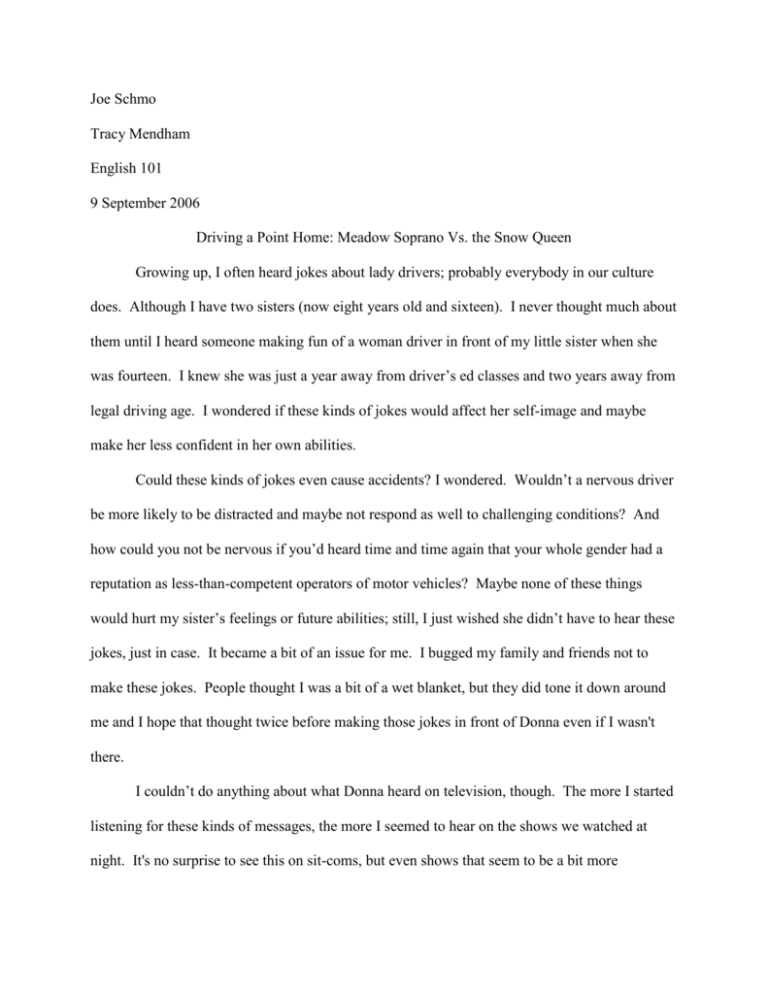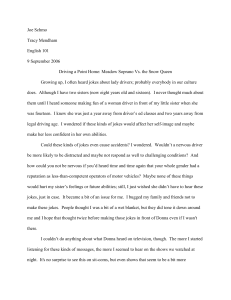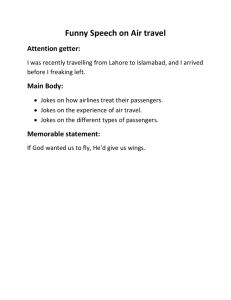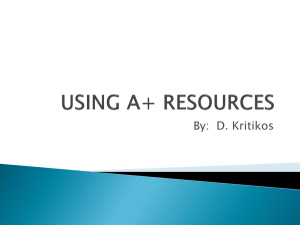Sample Student Essay in Word
advertisement

Joe Schmo Tracy Mendham English 101 9 September 2006 Driving a Point Home: Meadow Soprano Vs. the Snow Queen Growing up, I often heard jokes about lady drivers; probably everybody in our culture does. Although I have two sisters (now eight years old and sixteen). I never thought much about them until I heard someone making fun of a woman driver in front of my little sister when she was fourteen. I knew she was just a year away from driver’s ed classes and two years away from legal driving age. I wondered if these kinds of jokes would affect her self-image and maybe make her less confident in her own abilities. Could these kinds of jokes even cause accidents? I wondered. Wouldn’t a nervous driver be more likely to be distracted and maybe not respond as well to challenging conditions? And how could you not be nervous if you’d heard time and time again that your whole gender had a reputation as less-than-competent operators of motor vehicles? Maybe none of these things would hurt my sister’s feelings or future abilities; still, I just wished she didn’t have to hear these jokes, just in case. It became a bit of an issue for me. I bugged my family and friends not to make these jokes. People thought I was a bit of a wet blanket, but they did tone it down around me and I hope that thought twice before making those jokes in front of Donna even if I wasn't there. I couldn’t do anything about what Donna heard on television, though. The more I started listening for these kinds of messages, the more I seemed to hear on the shows we watched at night. It's no surprise to see this on sit-coms, but even shows that seem to be a bit more Schmo 26 sophisticated often convey the same damaging image, if more subtly. I was recently watching an old episode of The Sopranos, the men all seemed to be competent drivers, even under duress, but the one time we see a woman drive, it is young Meadow Soprano, stealing her boyfriend's car keys on a tipsy whim and then driving it right into a ditch. ("Save Us All.") She then throws herself sobbing into Jackie Junior's arms. Jackie and his friends, however, seem to arrive at and escape even their most ill-conceived, crank-induced heists without accident. I came to believe then--and still hold--that television exerted a negative force on the self-esteem of girls. Since I couldn’t prevent woman driver jokes, I had to think about how I could counteract them. One weekend I was had to baby sit and I was reading to my littlest sister, Donna, the fairy tales she liked so much. I was reading her "The Snow Queen" (Anderson 46-50). In the story, a boy named Kay gets into the Snow Queen’s sleigh. She’s not a very nice person, and the boy is somewhat lost before he even meets her. It’s a crazy ride and things go from bad to worse after that. But you know what? No one makes fun of the Snow Queen’s driving ability. She is the strong and kind of scary person in the story, and in her sleigh she is in control. When I was reading the story aloud to Donna I wasn’t worried about her growing up to think she was too stupid to be a good driver. We were both just hoping that Kay would escape the Snow Queen’s clutches. I realized then that some myths and fairy tales might be important and worth thinking about. An actual student essay would continue on from here, developing the ideas discussed in the essay. Here are some hints about formatting essays: You pretty much only have to think about how to format your paper the first time you do it. Have one good one that you keep as a model and then copy it each time and just put in the Schmo 36 new text. If you irrevocably confused, you can always go back to this one again. Don’t forget to change the date. The whole essay should be double-spaced. Sometimes there’s a temptation to put extra line spaces between things, but this is actually never necessary. In Microsoft Word, the short cut is Control-A to select all the text, and then Ctrl-2 to double-space it. Use one-inch margins top and bottom, left and right. In Microsoft Word you do this go going to the File menu, selecting Page Setup, and then under the Margins tab make sure it says 1” next to Top, Bottom, Left, and Right. If it doesn't, put in the right number and then click OK. If you're using Open Office instead of Microsoft Word, go to the Format menu, select Page, and then select the margins. In the upper left hand corner of the first page, put your name, then the instructor’s name, the title of the course, and then the date. Your essay should have a title and this comes next. Don’t italicize or underline or use all caps for your title. Just use “title case”—that means that the first letter of each important word is capitalized. Word will put it in title case for you if you select the text and then hit Ctrl-F3 two times to toggle through the cases. You’ll have to manually fix the capitalization of unimportant words like “the,” “and” and “or.” They should be lower-case unless they’re the first word. Put your last name and the page number in the top right of each page except the first one. To change the header, go to the View menu and choose Header and Footer. Type Ctrl-R to make the text flush right, type your last name, a space, and then click on the # sign in the toolbar. The correct page number will automatically appear on each page. This is how you get the header not to appear on the first page: When you’re in View Header, click on the symbol in the floating toolbar that looks like a book. Click the checkbox Schmo 46 next to Different First Page. Once you have a header, you can just double-click on it to get to View Header mode, without having to go through the menu. Start a new page for the works cited list. Type the heading Works Cited at the top and center it (select the text with your mouse or using the shift and cursor keys, then type Ctrl-E). Getting the entries in your Works Cited list can be tricky. Put them in alphabetical order by the author’s last name (or if there’s no author name, by the title of the work). Microsoft Word can do this for you, too. Select the text with your mouse or shift key. (Don’t use Ctrl-A because it will alphabetize your whole paper.) Then go to the Table menu and choose Sort. It will probably go right to the correct defaults (Sort by Paragraphs, Type: Text, and Ascending) and when you click on OK, it will sort your entries for you. For each entry in the works cited list, you want a hanging indent. That means the first line is flush left, and if the entry runs more than one line, the subsequent lines are indented. This is what you really need Word to help you out on. Select the text of the entries again. Go to the Format menu and choose Paragraph. Next to Special, choose Hanging from the drop-down menu, and then hit OK. If something goes wrong, undo with Ctrl-Z. If you're emailing the essay to me, it should be saved as a Word (.doc) or Rich Text Format file. If the name of your document already ends with a period and then then the letters doc or rtf, it's probably all right. If it's a WordPerfect or Microsoft Works file, to change it go to the File menu, choose Save As, and then in the box next to “Save as type” click the drop-down menu (the little triangle) to show your list of options, and choose either Microsoft Word (97/XP/2000 if you have a choice of several versions of Word) or Rich Text Format. Then click OK, and then make sure you email me the right one! Schmo 56 Any useful shortcuts or rules of MLA formatting I didn’t mention? Let me know so I can improve this sample essay for students in my next course.Works Cited "Save Us All From Satan's Power." The Sopranos. Dir. David Chase. HBO, February 25, 2002. Andersen, Hans Christian. "The Emperor's New Clothes." Anderson's Fairy Tales. Project Gutenberg. 1 Oct. 2004 <http://www.gutenberg.org/dirs/etext99/hcaft10.txt>. Andersen, Hans Christian. "The Snow Queen." Anderson's Fairy Tales. Boston: Little, Brown, 1975. Baum, L Frank. The Wizard of Oz. New York: Delrey Ballantine, 1979. Doontexist, Suzie. "Powergirls: What We Lose By Letting Girls Skip Metal Shop." International Journal of Gender Studies 20.3 (1999): 32-34. Academic Search Premier. EBSCOhost. Keene State College Library, Keene, NH. 2 Oct. 2004 <http://search.epnet.com>. McIntosh, Midge. Personal Interview. 22 Feb 2004.






